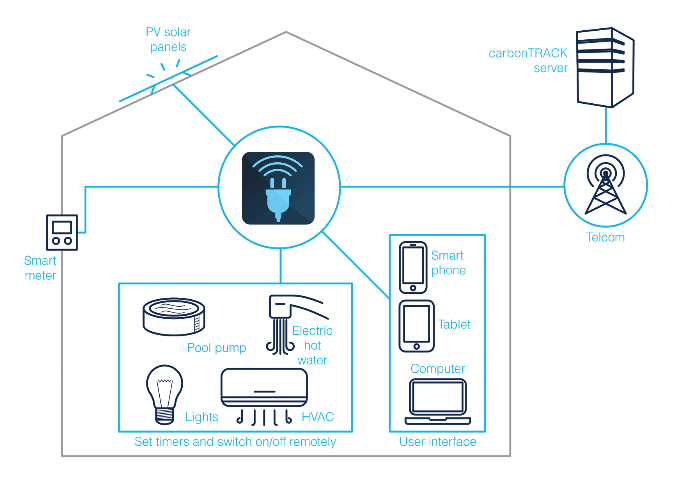On December 31 2016, recipients of NSW Solar Bonus Scheme will cease to receive bill credits for their exported solar energy. The Solar Bonus Scheme (which closed to new applications in 2011) offered 60c per kilowatt-hour or 20c/kWh, depending on the signup date. Once the scheme ends, these rates will drop significantly (to as low as low as zero), depending on your electricity retailer and the plan.
Now, as these state-sponsored rates come to a close, the 150,000-odd NSW solar homes receiving them are looking to make the transition as painless as possible. If you live in one of these homes, what are your options? In this article, we break them down for you.
Your goal: Self-consume as much of your solar energy as possible
The 60c/kWh rate – and to a lesser degree the 20c/kWh rate – both essentially incentivise solar homes to send their solar energy into the grid. These days, with feed-in tariff rates only a fraction of what they once were, the opposite is true: in order to maximise the value of your solar system, you should focus on ‘self-consuming’ as much of your solar energy as possible. By using your solar energy yourself, you’ll reduce your electricity bill directly – and you’ll also have the pleasure of knowing that you’re at least partially energy self-reliant.
Your options for maximising solar energy’s value
In the run-up to the end of the Scheme, there are a range of actions you can take to make sure that as little of your precious solar energy as possible ends up being sent into the grid – or if it does, that you’re getting paid as much as possible for it. We’ve explained each of these actions below (not all of which can be implemented simultaneously), and have also laid them out in a handy comparison table at the bottom of the article.
Get a net meter
Solar Bonus Scheme recipients are almost all on a ‘gross’ metering setup, which means that all of your solar energy is automatically sent into the grid. In order to self-consume any of your solar energy, you’ll need to switch to a ‘net’ metering setup, which will only allow your solar energy into the grid if your home isn’t running enough devices to use it all.
More than being just a good idea, switching to a net metering setup is absolutely essential. If you don’t swap out your meter before the end of the year, you may end up getting *zero* for your solar energy. This is a situation you do not want to end up in, for obvious reasons.
At the same time, you want to ensure that you can continue receiving your feed-in tariff payments right until the scheme ends. Solar Citizens and the Alternative Technology Association (ATA) have put together an excellent report on the topic of the end of FiTs in various states (including NSW), in which they discuss the switch from gross to net metering on pages 4-5. We recommend that you read it yourself, but the gist of it is as follows:
- You may be able to opt to have your metering setup upgraded by your electricity distributor (your local network – not your retailer). Depending on which distributor owns the infrastructure that delivers energy to your home (Endeavour, Essential Energy or Ausgrid), you may pay anywhere from $150-$700 to have your metering arrangement switched from gross to net.
- Alternatively, you can have your metering setup upgraded by an energy retailer – a company that sells you electricity. It doesn’t have to be your current retailer, and in fact it is worth shopping around to see who is offering the best deal – just be careful that you’re not getting locked into a retail electricity contract in doing so. (Mojo Power is one company who is promising a free smart meter installation and no long-term contract. Their meter will automatically switch your billing from gross to net on 1 January 2017.)
Set up timers to run devices during the day
Most households are empty during the sunniest hours of the day, when solar panels are pumping out the most energy. By putting devices on timers, it may be possible to capture a chunk (or all) of the solar energy that would otherwise be wasted.
Keep in mind, however, that most timers are not ‘smart’ enough to know if there is actually solar energy available to be used. This isn’t much of an issue if you’re on a flat rate electricity tariff, but it could potentially result in overall higher bills if you’re on a time-of-use tariff, in which case you might be better off running your devices at night (during ‘off peak’ times & rates) if the solar resource isn’t available.
 Get a hot water diverter
Get a hot water diverter
Hot water diverters are devices that send solar energy into your hot water tank when they sense that it isn’t being put to better use. Given that water heating accounts for around 30% of the average household’s energy bills, this is certainly an attractive option.
While you should ensure that it wouldn’t be more cost-effective to instead run your water heater as an off-peak ‘controlled load’ on a separate circuit (ask your electricity retailer about this option), for many homes with electric hot water and plenty of excess solar energy, a diverter might be the better choice – they cost about $700-$1500 to have installed.
We’ve estimated that in the right circumstances, a diverter can reduce a solar system’s payback time by at least a few months (and up to a year) and increase annual bill savings by 25% or more.
Install an energy management system
An Energy Management System (EMS) is a combination of software and hardware allows you to 1) monitor energy flows in your home and 2) control your devices according to a program that you set or manually/remotely from a smartphone app.
In the best case scenario, an EMS will ‘know’ when you’ve got some extra solar energy kicking around, and turn on devices at opportune times to soak it up – for example, switching on the washing machine or dishwasher when your solar array is at peak production in the afternoon.
But more commonly and on a more basic level, an EMS gives you a bird’s eye view of electricity usage in your home in order to take actions (programmed or manual) that will improve your savings. Most EMSs can also control your water heating, making them significantly more versatile than hot water diverters at around the same cost.
Another bonus to having an EMS is that it can help you to determine what size battery bank you’ll need if you’re thinking about installing battery storage in the near future – based on real data from your home. This will help take the guesswork out the process and deliver confidence that you’re not spending more money than you have to.
There are a wide range of companies that make EMSs, including SMA, Enphase and Panasonic (read about more here). carbonTRACK, an Australia-based EMS developer, says that an EMS can help a home reduce their electricity bills by over 30% through a combination of increased solar self-consumption and smarter use of devices throughout the day.
 An example of how a home energy management system works – this one from carbonTRACK. The graphic shows how the carbonTRACK EMS coordinates between your solar, household devices and (coming soon) battery bank in accordance with how you’ve programmed it via their smartphone or desktop interface.
An example of how a home energy management system works – this one from carbonTRACK. The graphic shows how the carbonTRACK EMS coordinates between your solar, household devices and (coming soon) battery bank in accordance with how you’ve programmed it via their smartphone or desktop interface.
Get a battery storage system
Home battery storage is arguably the hottest energy-related topic in Australia at the moment, and by almost all accounts the market for residential battery systems is set to take off dramatically in the coming years. The thing that is great about batteries is their versatility – the electrical energy that they store can be used to run virtually anything in your home, and their output is more reliable than that of a solar panel array (whose output may drop suddenly if a cloud passes in front of the sun).
Furthermore, with the right setup, you can even top your batteries up using grid electricity in addition to solar energy from your panels – helping you to save money through tariff arbitrage (if you’re on a time of use tariff). Coupled with enough solar PV capacity, battery storage could even help you become nearly or completely energy self-sufficient (off-grid living, anyone?)
The biggest downside of battery storage at the moment is price: while batteries may help you reduce your energy bill significantly, except in a few situations, they’re unlikely to have a payback period shorter than their warranty duration.
You can read more about battery storage options for NSW homes coming off the Solar Bonus Scheme here.
Check around to see if you can get a higher solar feed-in tariff
This isn’t really about solar self-consumption, but it may help with optimising solar value for a home. NSW no longer has a mandated minimum amount that your retailer must pay you for your solar energy. While the regulator (IPART), annually publishes a benchmark range, this is only a suggestion (seriously!). The idea is that retailers will compete for solar customers by setting their own feed-in tariff rates.
Currently, the highest rate available in NSW is 10c/kWh – but we caution shoppers to make sure that this higher rate is not offset by other components of the plan (such as higher daily supply charges or usage charges). As we’ve noted here, a higher feed-in tariff does not guarantee a better overall deal.
Solar self-consumption option comparison matrix
We’ve put the below table together to help you narrow down your options and make a decision.

This Solar Choice article was first published on RE sister site, One Step Off The Grid. To sign up for the weekly newsletter, click here.











